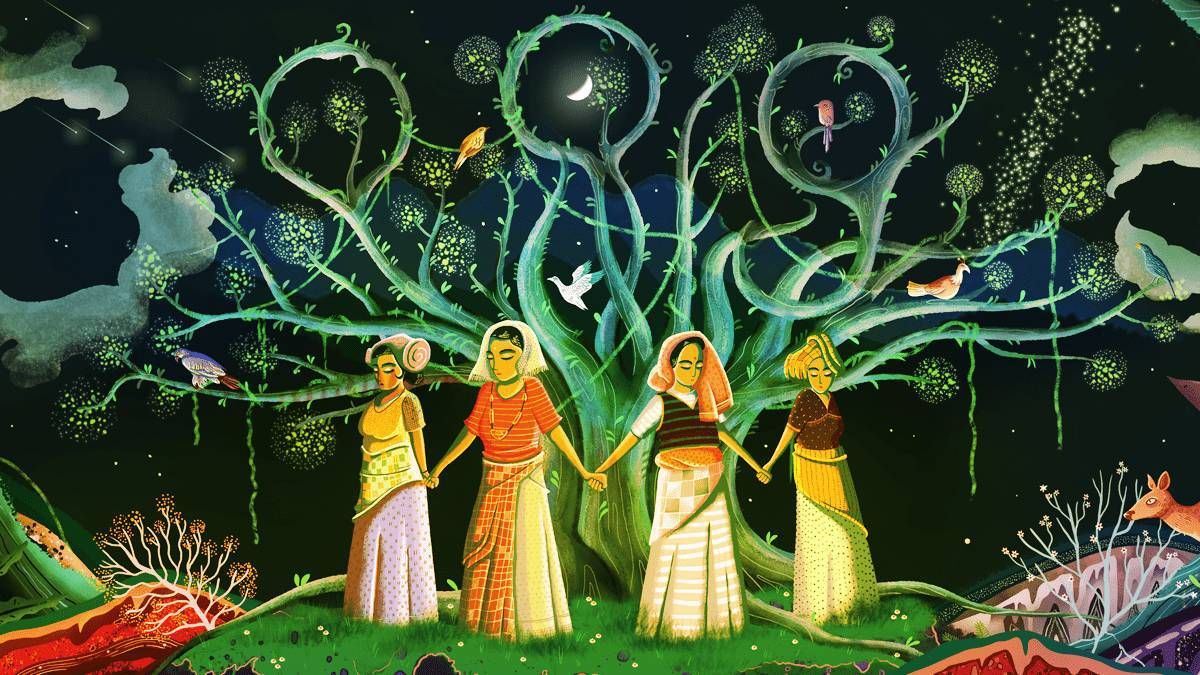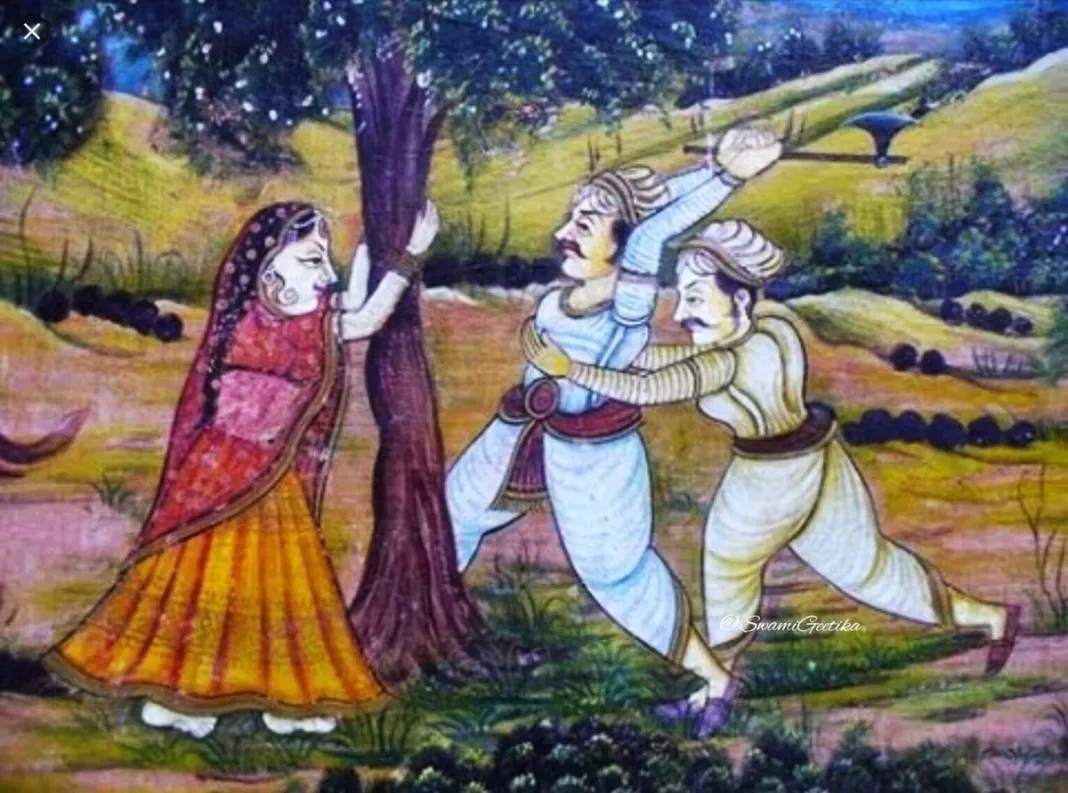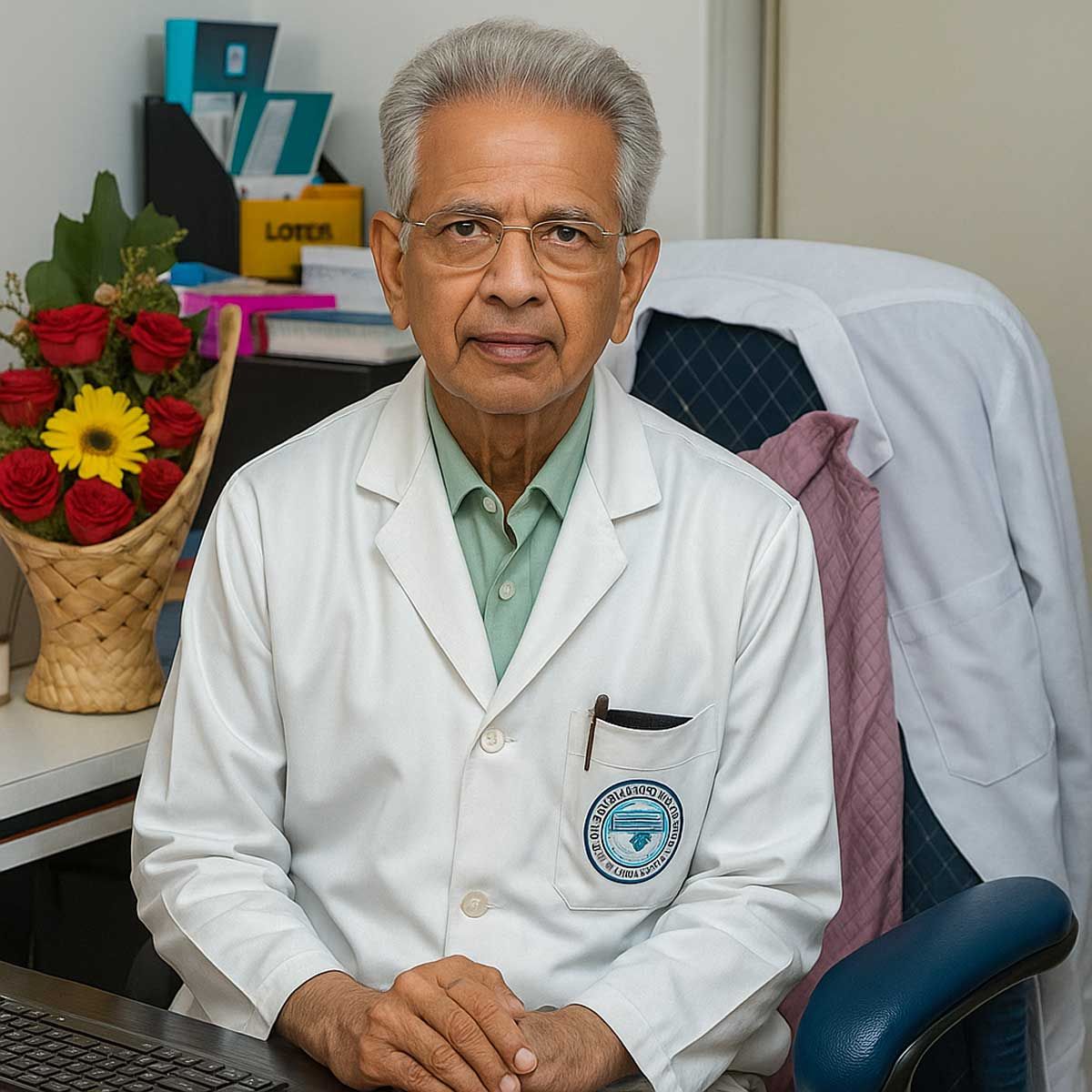More Coverage
Twitter Coverage
Satyaagrah
Written on
Satyaagrah
Written on
Satyaagrah
Written on
Satyaagrah
Written on
Satyaagrah
Written on
JOIN SATYAAGRAH SOCIAL MEDIA
Chipko Andolan: Cut me down before you cut them down

Today while running through deep searches for some specific content regarding Mohandas Karamchand Gandhi I came across mention of this author Ramchandra Guha. So, when Amazon was showing books written by him, there was this one book which caught my attention immediately "Chipko Movement". Excited to know what this movement was all about as I have never heard of any such andolan before in my life, I started going through many articles and synopsis submitted on the topic.
We have always been told that as a Sanatani, that we pray nature, but does it mean one would be ready to giver his/her life for that? Well, Chipko Movement was one such agitation where women of villages would go and hug tree tightly so that it can not be cut by contractors for commercial purposes. Their intention were very clear "let our bodies be cut, before tree can be touched".
As we watched with shock the videos from Uttarakhand, of a flooding river rushing down the mountains in a wave of fury and destruction, it seemed obvious that an ecological balance is urgently needed to face the challenge of climate change in our century.
In 1730, 294 men and 69 women belonging to the Bishnois branch of Hinduism, died while trying to protect the trees in their village from being turned into the raw material for building a palace. They literally clung to the trees, while being slaughtered by the foresters. But their action led to a royal decree prohibiting the cutting of trees in any Bishnoi village. And now those villages are virtual wooded oases amidst an otherwise desert landscape.
This act of bravery of Bishnois inspired the Chipko movement (which literally means the "movement to embrace", “to cling” in Hindi) that started in the 1970s, when a group of peasant women in the Himalayan hills of northern India threw their arms around trees designated to be cut down.
"NO WOMAN ever had to hug a tree to protect it," says Chandi Prasad Bhatt, the founder of Chipko. "It was not necessary to do so, for the mere threat was enough." The concept of hugging a tree to defend it was so powerful, it brought in a new consciousness to the country that put environment at its centre.
 |
Chipko -- "to hug" in Hindi -- today evokes romantic images of poor, village women in the hills of northern India determinedly hugging trees to prevent them from being cut down by the very axes of forest contractors that also threatened their lives. But Chipko's multi-faceted identity has resulted in it meaning different things to different people. For some, it is an extraordinary conservation movement of the poor; for others, it is a local people's movement to regain control of their natural resources, snatched away first by a colonial power and then by the free government of India, and, finally, it is a movement of women trying to save their environment with a message to loggers: "Our bodies before our trees". In fact, as a women's movement, it inspired eco-feminism in India and, to some extent, throughout the world.
The volume of literature Chipko generated is enormous, but, today, 20 years after its birth, questions remain: What has been its impact locally, nationally and internationally? Did it achieve its objectives or were its gains only intellectual, with few benefits for the villagers?
Background
At least a third of the area in a country should normally be under forests. Only then can environmental problems be solved. In India, forests do not cover even half of the required area, and remaining forest area is declining rapidly because of the Industrial and urban demands. Satellite pictures proves that India is losing forests at the rate of 1.3 million hectares a year. These figures are eight times those given by the Forest Department.
Not only are our forests being logged but forest land is also being used for various "development" projects such as damns, river valley projects, industries, roads and agriculture. Between 1951 and 1975-76, 4.2 million hectares of forest land was used for these projects, despite the fact that forest area per person in India is now only 0.14 hectares. The demand for forest product is increasing geometrically. This is a frightening situation and it shows why it is so important to protect the remaining forest vegetation.
The Government itself is a culprit in the exploitation of forests in the name of so-called welfare. Destruction continues in the name of development. Most villages in the 3rd world have a lifestyle that is largely dependent on forests. Their daily needs for energy, fodder for animals, and wod for huts and homes are all met by forests. Even today, village people use mainly wood as their source of fuel for cooking. People living in villages and backward areas now have to walk miles to collect wood. In the Himalayan areas of Uttar Pradesh, forests have receded so far away from villages that women have to leave home as early as four o'clock in the morning to fetch wood and they return late at night after long journeys, up and down hills, with a load of 25-30 kg. This problem is becoming more and more acute.
The Himalayan region is characterized by high mountains and valleys, with different types of vegetation, flowers, pastures and glaciers. This is one of the most beautiful areas in the world. It keeps the atmospheric circulation in balance over a large part of the Indian subcontinent. This region also gives rise to the Ganga-Yamuna River system with tributaries such as the Bhagirathi, Alakananda, Sharda and others. These rivers are born out of glaciers. As they pass through forest-covered mountain valleys, they collect water from hundreds of streams before they enter the plains to become the source of life for millions of people. The rainwater from these forests is released gradually over the year to the rivers. The forests help prevent soil erosion and the food system also depends on these forests.
India’s forests have long been among the country’s most essential resources, ensuring the livelihoods of forest-dwelling and rural communities while also maintaining ecological balance. Under British colonial rule, laws were introduced - known as the Indian Forest Acts of 1878 and 1927 - to allow the government to manage natural resources. These laws gave the state the right to exclusively control the use of certain areas, which had an overwhelmingly negative impact on communities that had traditionally relied on forests for their survival.
With the conclusion of the Sino-Indian border conflict in 1963, the Indian state of Uttar Pradesh experienced growth in development, especially in the rural Himalayan regions. The interior roads built for the conflict attracted many foreign-based logging companies that sought access to the region’s vast forest resources. Although the rural villagers depended heavily on the forests for subsistence—both directly, for food and fuel, and indirectly, for services such as water purification and soil stabilization—government policy prevented the villagers from managing the lands and denied them access to the lumber. Many of the commercial logging endeavours were mismanaged, and the clear-cut forests led to lower agricultural yields, erosion, depleted water resources, and increased flooding throughout much of the surrounding areas.
 |
The movement
In 1964 environmentalist and social activist Chandi Prasad Bhatt founded a cooperative organization, Dasholi Gram Swarajya Sangh (later renamed Dasholi Gram Swarajya Mandal [DGSM]), to foster small industries for rural villagers, using local resources.
Soon villagers and women, began to organize themselves under several smaller groups, taking up local causes with the authorities, and standing up against commercial logging operations that threatened their livelihoods.
In October 1971, the Sangha workers held a demonstration in Gopeshwar to protest against the policies of the Forest Department. More rallies and marches were held in late 1972, but to little effect, until a decision to take direct action was taken.
The government’s forest policy, which the villagers saw as unfavorable towards them. The Sangh also decided to resort to tree-hugging, or Chipko, as a means of non-violent protest.
There was discontent among the people with regard to deforestation prior to the 1960s, but they received their biggest shock of the decade, when trees were cut on a large scale. This increased the intensity of the 1970 flood in the Alakananda river, which swept away six bridges, 16 footbridges and 25 buses. Hundreds of people and animals died. In 101 villages, 604 houses and 500 acres of crops were destroyed. Roads were blocked. Similarly, 300 kilometers away, the Upper Ganga canal was silted two to three metres deep for a length of ten kilometres. The canal was canal closed and crops in crops in an area greater than 380,000 hectares were affected.
Hastened by increasing hardships, the Garhwal Himalayas soon became the centre for a rising ecological awareness of how reckless deforestation had denuded much of the forest cover, resulting in the devastating Alaknanda River floods of July 1970, when a major landslide blocked the river .
The people of the economically backward Uttarakhand region, situated in the central Himalayas, raised their voice for the first time through the Chipko movement (also known as Chipko andolan), to say that their life and livelihood is mainly dependent on forests. Their relationship with the forests operates on two levels: first, through the maintenance of the ecological balance and second, through traditional practices.
DGSM became a force of opposition against the large-scale industry. The first Chipko protest occurred near the village of Mandal in the upper Alaknanda valley in April 1973. The villagers, having been denied access to a small number of trees with which to build agricultural tools, were outraged when the government allotted a much larger plot to a sporting goods manufacturer. When their appeals were denied, Chandi Prasad Bhatt led villagers into the forest and embraced the trees to prevent logging. After many days of those protests, the government canceled the company’s logging permit and granted the original allotment requested by DGSM.
In Chamoli district, the villagers of Mandal, led by Bhatt and the DGSM, prevented the Allahabad-based sports goods company, Symonds, from felling 14 ash trees. This act took place on April 24 and, in December, the villagers again stopped Symonds agents from felling in the Phata-Rampur forests, about 60 km from Gopeshwar.
The final flash point began, when the government auctioned 2,500 trees (680 hectares) to Jagmohan Bhalla, a contractor from Rishikesh. It was near Reni village, overlooking the Alaknanda River.
Gaura Devi led 27 of the village women to the site and confronted the loggers. When all talking failed, and the loggers started to shout and abuse the women, threatening them with guns, the women resorted to hugging the trees to stop them from being felled. This went on into late hours. The women kept an all-night vigil guarding their trees from the cutters until a few of them relented and left the village. The next day, when the men and leaders returned, the news of the movement spread to the neighbouring Laata and others villages including Henwalghati, and more people joined in. Eventually, only after a four-day stand-off, the women of Reni drove out the contractor's laborers on March 26, 1974.
This was a turning point for Chipko, as it marked the first time that the initiative by women, especially when their menfolk were not around. The Reni incident also prompted the state government to set up a nine-member committee, chaired by Delhi botanist Virendra Kumar and whose members included government officials; local MLA, Govind Singh Negi of the Communist Party of India (CPI); Bhatt, and Govind Singh Rawat, the block pramukh of Joshimath. The committee's report, submitted after two years, led to a 10-year ban on commercial forestry in Reni and in nearly 1,200 sq km of the upper catchment of the Alaknanda.
Women’s participation in the Chipko agitation was a very novel aspect of the movement. The movement achieved a victory when the government issued a ban on felling of trees in the Himalayan regions for fifteen years in 1980 by then Prime Minister Indira Gandhi, until the green cover was fully restored.
Another response to Chipko was the formation of a Van Nigam, a state-owned forest corporation, in 1975 to take over all forms of forest exploitation from private contractors. "It was generally believed," says Surendra Bhatt, a veteran Sarvodaya worker of Uttarkashi, "the government would not be as ruthless and corrupt as private contractors in exploiting forest resources." But this belief was unjustified for many agitations were targeted in time against Van Nigam.
 |
The protests spread Meanwhile, other protests were staged in the Uttarakhand region. In 1974, a struggle was launched on July 25 -- and reached its peak in October -- by villagers from the Vyali forest area near Uttarkashi, seeking to halt tree-felling. In Kumaon, Chipko made its debut at the Nainadevi fair in Nainital in 1974, and then proceeded to block forest auctions at several places, including Nainital, Ramnagar and Kotdwar. The movement in Kumaon gathered momentum following major landslides at Tawaghat in 1977 and student activists successfully blocked the auction at Shailley Hall in Nainital on October 6, 1977. On November 28, another protest of students was forcibly dispersed by the police and many of the activists were arrested. The Nainital Club was set ablaze and this led the police to open fire. Says poet Girish Tiwari "Girda", whose folk songs inspired Chipko rallies, "In 1942, during the Independence movement, the British fired two rounds in Nainital. Since then, there never was any firing in Nainital."
In Tehri Garhwal, meanwhile, Chipko activists led by Sunderlal Bahuguna began organising villagers from May 1977 to oppose tree-felling in the Henwal valley. They resorted to direct action in December 1977 to protect the Advani and Salet forests and in March the following year, 23 volunteers, including women, were arrested for opposing a forest auction at Narendranagar. "The struggle in Henwal," recalls Pratap Shikhar, "marked the transformation of Chipko from an economic struggle to a fight for conservation." The agitation to save the Badyargarh forests gained momentum after the jailing of Bahuguna, who began on January 9, 1979.
Chipko resumed activities in Chamoli during 1977-78, with the women from Pulna stopping the felling of forests in Bhyunder valley. Similar protests were staged in Doongri-Paintoli in 1980, and in Bacher, as late as 1984-85. "But by then, the Chipko protests were breathing their last," says Sudarshan Kathait of Gopeshwar, who was actively involved in the Chanchridhar struggle. "After early gains, Bhatt began to spend more time on plantation work, eco-development camps and organising women into Mahila Mangal Dals (MMDs). And Bahuguna did not believe at that time in plantations, though he is currently involved in promoting afforestation."
After Bahuguna met British forester Richard St. Barbe Baker in 1977, he became an ardent conservationist and in April 1981, he went on an indefinite fast in support of his demand for a total ban on felling in the Himalaya above 1,000 m. Indira Gandhi, who was prime minister then, set up an eight-member expert committee to look into the matter. Although the committee exonerated the forest department and its sustained yield forestry policy, the government instituted a 15-year moratorium on commercial felling in the Uttarakhand Himalaya.
Long before the moratorium, however, it had become clear that Chipko had significantly slowed the march of commercial forestry: The output of major forest produce from the eight hill districts declined from more than 62,000 cubic metres in 1971 to 40,000 cum in 1981.
The roots
According to social historian Ramachandra Guha, author of The Unquiet Woods, Chipko is the latest in a long series of peasant protests going back to the turn of the century against commercial forestry in the Uttar Pradesh Himalaya in the Uttar Pradesh Himalaya. In 1916, British officials were nonplussed at the "deliberate and organised incendiarism" by the people of Kumaon to the opening up of forests to commercial exploitation, but that also deprived the people of their traditional rights. The 1916 agitation, which began as a general strike against utar (forced labour) and then became a systematic campaign in which chir (pine) forests were burnt down all over Kumaon, especially in Almora, led to the formation in 1921 of the Kumaon forest grievances committee.
In Garhwal, a protest that is still remembered is the one the local people refer to as the infamous Tilari kand (incident). On May 30, 1930, a massive satyagraha was held at Tilari against the forestry policies of Tehri Garhwal state, which were similar to those introduced by the British in the rest of Uttarakhand. The maharaja of Tehri was in Europe and his prime minister, Chakradhar Juyal, crushed the Tilari protest in a replay of the Jallianwala Bagh incident. Soldiers shot down unarmed people, including children, and many drowned in the Yamuna while trying to flee.
Protests over forest policies deemed inimical to local needs continued after Independence. The 1962 Indo-Chinese war opened up border areas to development. An extensive network of roads ran deep into the hills, literally opening the way for a wave of forest officials and contractors. Most of the labourers were recruited from outside the region and their work triggered landslides, soil erosion and irreversible damage to watersheds. The local villagers got nothing except damage to their environment.
DGSM became involved in anti-liquor campaigns, in the construction of roads, including one running through Gopeshwar, and in setting up a resin factory and a saw mill there. However, DGSM's attempts at cottage industry-scale development ended disastrously in the face of competition from established firms and the forest department's preference to supply forest raw material to outside industrialists than to local, cottage industries.
DGSM with the blessing of the Sarvodaya movement, worked to promote Vinobha Bhave's concepts of gramdan and of a non-violent, self-reliant, village society based on rural industries. DGSM became involved in anti-liquor campaigns, in the construction of roads, including one running through Gopeshwar, and in setting up a resin factory and a saw mill there. However, DGSM's attempts at cottage industry-scale development ended disastrously in the face of competition from established firms and the forest department's preference to supply forest raw material to outside industrialists than to local, cottage industries.
The Sarvodaya campaign against alcohol provided a platform for women, but increasingly it was the conflict between local and outside contractors over forest exploitation that became the rallying point for popular protest during the 1960s. At a memorial meeting at Tilari in 1968, the people in Garhwal renewed their resolve to fight for forest rights. The Alaknanda floods of 1970 gave further impetus to the protests against outside contractors, which peaked in 1972 with demonstrations in Purola on December 11, in Uttarkashi on December 12 and in Gopeshwar on December 15.
These demonstrations failed to move the state and local activists began to look for new ways to protest. In its first phase, Chipko sought to force the government to end its preference for big, outside forest contractors and instead award contracts in small lots to local labour cooperatives. It wanted an end to the export of raw material from the region and start local forest-based industries. Chipko aimed at ushering in forest management policies that would meet the needs of the local villagers.
Kathait agrees, saying, "Chipko was primarily an economic struggle. Environment and ecology were attributed to it later and Bahuguna started projecting it as a conservation campaign. The local people wanted their economic survival first."
An illustration of local economic compulsions is the Mandal incident, which H K Singh of Gopeshwar College says had its roots in 1969. "The files of late Subedar Bachan Singh Bist of Mandal, the Symonds' contractor between 1969 and 1972, show that he did not get the contract because he demanded exorbitant wages for labourers," Singh explains. "He then organised a meeting in Mandal on March 18, 1973, where leaders like Alam Singh Bist, the pradhan of Khalla village, and Bachan Lal, the secretary of the Shoshit Dal (Depressed Classes' Association), threatened to hug trees if Symonds brought in outside labour. Bhatt was away then from Gopeshwar and the Mandal meeting was a local affair, without any mass participation."
As it turned out, on April 24, DGSM workers and students and villagers from Gopeshwar held a rally to prevent Jagadish Prasad Nautiyal, a Symonds sub-contractor, from entering the forest. Bhatt, too, opposed the felling of trees by outside contractors because it was DGSM's aim to establish cottage-scale industries through local labour cooperatives.
Says Nautiyal, now gram pradhan of Banglo-ki-Kandi village near Mussoorie, "I was a sub-contractor of Symonds. Earlier, I had worked as a labourer. In 1973, I got the contract for felling trees in Pangarbasa forest near Mandal village. That was the first time I got a contract and, as it turned out, the last. Bhatt said he would not allow the felling and the villagers threatened to hug the trees.
"I got scared and did not go to the forest. Instead, I met district forest officer Narinder Singh Negi, who asked me to wait till he could pacify the DGSM workers. After three months, I was permitted to fell trees in Phata in the Kedarnath division. But the DGSM got there, too. I lost Rs 32,000 in payments to 17 labourers. The DGSM didn't chipko any tree, but it put up posters against me all over Gopeshwar even though I had not engaged any Nepalese labourers. The workers were from my village."
Meanwhile, during October-December 1973, Bahuguna undertook a padyatra between Gopeshwar and Ukhimath to publicise the need to save trees and to expound the philosophy of non-violent direct action. Symonds agents also staged padyatras, going from village to village and explaining they had already paid for the trees. The agents also spread a rumour that a movie was being screened in nearby Rampur and when the villagers guarding the forest left their post, they quickly felled five ash trees. But the villagers returned the next morning, disappointed because there was no movie, and were able to drive off the contractors, who had to leave the trees behind. More demonstrations followed until December 31, when the Symonds permit expired. But Nautiyal says he had to leave earlier because "my dwindling resources ensured that I quit the whole business in three months."
 |
Chipko's impact
The transformation of Chipko from a struggle to control local resource use to a national movement was influenced heavily by a growing global environmental concern. Chipko began independent of global environmental consciousness, but in interacting with the rest of the world, Chipko assumed a deep conservationist bearing.
Reacting to Chipko in 1980, Indira Gandhi told Nature magazine in an interview, "Well, frankly, I don't know all the aims of the movement. But if it is that trees should not be cut, I'm all for it." When informed that Chipko was concerned also about poverty in the region, she replied, "Naturally, anybody who lives in a backward country has to be concerned with that, too." But clarifying that trees are important in themselves, she added, "The cutting of trees has immediately brought havoc because it has increased our drought, it has increased our floods and it has made vast areas much more difficult to live in."
Irrespective of Chipko's grassroots achievements, it accomplished a lot at the national and international levels. Says Shekhar Pathak, a Chipko activist now teaching history at Kumaon University in Nainital, "A distinction is necessary between what happened locally and the national and international movement that grew out of it. Chipko put forests on the political agenda in the country. The Forest Conservation Act of 1980 and the very creation of the environment ministry are due to the consciousness created by Chipko."
And Nirmal Kumar Joshi, director of the Forest Training Institute at Haldwani, adds, "Chipko created a new wave of understanding among foresters. We realised that our plans to exploit forests were not at all scientific, as it was claimed. We realised that nurseries and plantations were more important than cutting down green trees."
International ecologists saw Chipko as a cultural response of the people's love for their environment. Chipko was popularised by the feminist movement, who pointed out that village women have to walk long distances to collect fuel and fodder and they become the first victims of forest destruction. Eco-feminists argued that women are therefore closer to nature and more ecologically conscious.
But Chipko's biggest contribution probably was the pro-poor environmentalism that it brought in its wake. Says Mahendra Singh Kunwar, who was a student during Chipko's heyday, "It dismissed the notion that the poor destroy their environment and do not want to protect it. The Chipko message captured the imagination of activists across the world. Until Chipko, people refused to believe the poor could live in harmony with their environment.
"Chipko had a very humane appeal: Cut me down before you cut down the tree. The tree is far more important than my life, it is the basis of my survival."
Several environmental activists discerned in Chipko a powerful assertion of people of their rights over their environment. This concept, in fact, set a major trend in environmentalism, and one Chipko observer has written, "Local control over the habitat -- in this case the forests -- might have been illegal in terms of contemporary laws, but it was not immoral."
This was the true social justification of the protests, which defined a new morality in environmental concern. "This gave rise to the notion of the need to empower local communities to manage their resources," says Shamser Singh Bist, an ardent Chipko activist.
Several USV activists formed the Uttarakhand Kranti Dal, which is leading a movement for the region to be given statehood. Dal activists felled thousands of trees throughout Garhwal and Kumaon during their 1988-89 ped kato andolan (fell trees movement), which was launched to counter delays in environmental clearance for road and water pipeline projects.
It is indeed an irony that the very region that gave Chipko to India and the world now has activists promoting the ped kato andolan. Gayatri Devi, the heroine of the Doongri-Paintoli struggle, says, "Earlier, we could fight the contractors, but now the sarkar and the Van Nigam are the biggest contractors. How can we fight them?"
Bahuguna describes his agitation against the Tehri dam as a continuation of Chipko. Bhatt, too, calls his campaign against the extension of the Vishnuprayag hydroelectric project to the Bhyunder valley and his encouragement of the afforestation work undertaken by MMDs as Chipko-related.
Bhatt explains he has moved on to what he calls rachnatmak (constructive) activities, primarily involving women in tree-planting. The trees they plant, he adds, generally have a higher survival rate than forest department plantings. DGSM holds a number of three-day environment camps annually and they attract a few hundred people each. In 1986, MMDs of 30 villages where the DGSM worked got the Priyadarshini Vrikshamitra Award of the then National Wastelands Development Board.
 |
Conclusion
As the movement continued, protests became more project-oriented and expanded to include the entire ecology of the region, ultimately becoming the “Save Himalaya” movement. Between 1981 and 1983, Bahuguna marched 5,000 km (3,100 miles) across the Himalayas to bring the movement to prominence. Throughout the 1980s many protests were focused on the Tehri dam on the Bhagirathi River and various mining operations, resulting in the closure of at least one limestone quarry. Similarly, a massive reforestation effort led to the planting of more than one million trees in the region.
Society must become a partner in forestry. Governments must realize that the human pressure on forests has increased so much that forests have disappeared near human settlements. Forest lands are lying barren, while people have to go far into government forests to meet their needs. People want to be liberated from this situation and want forests of their own, into which they can go as a matter of right. They do not want to fight all the time or be humiliated.
Programs should be such that every village – and if possible, every family – can have trees of its own. The government controls the forests around many villages. Such forests should be taken away and handed over to village communities. The money allocated for village forests should not be given to government departments but to village councils and voluntary agencies situated in the villages. Every four or five villages should have a Forest Department worker who can assist the villagers to meet their needs.
It is also important that those varieties of plants be provided which match local needs and ecological conditions, and that afforestation is taken up as people’s movement. Planning will have to be undertaken at the village level itself, so that people participate in forest conservation in a practical way.
Today, the impact of deforestation on the ecological balance is not restricted to a particular area or country. This is a worldwide problem. It can be solved only with the participation of the common person.
 |
Do we need Chipko Movement today? May be Yes
DEHRADUN: In October 2020 residents and wildlife conservationists in Uttarakhand announced a ‘Chipko Movement’ to save 10,000 trees in Shivalik Elephant Reserve, one of the premier reserves for pachyderms in the country, which are proposed to be felled for expansion of Dehradun airport. Citizens will tie “protection threads” around the trees over the next few days to register their protest. The move is meant to invoke memories of the famous ‘Chipko Andolan’ in the 1970s in the hill state when villagers in Chamoli district hugged trees to prevent contractors from felling them.
The new ‘Chipko’ movement will have a digital footprint as well, with citizens starting online signature campaigns to garner support for their cause. Aanchal Sharma, a 28-year-old dentist, whose campaign on change.org urging the government to roll back its decision has garnered over 10,000 signatures within two days, said, “We don’t want our town to become a concrete jungle where there is no space for trees or animals.” <br>The campaign addressed to the chief minister said that the area must be preserved as it is the “green lung of the city” and home to elephants, leopards and over 125 species of birds.
|
TOI had earlier reported that the trees would be felled as Uttarakhand forest department has decided to give up 215 acres of land of the reserve which also has notified elephant corridors within a radius of 3 km.
Another city-based activist Ayush Joshi added that his team would carve out an elephant out of solid waste and install it in the city to urge others to join the cause.
Others are exploring legal options as well. Himanshu Arora, secretary, Citizens for Green Doon, said the forest is home to pangolins which are already on the verge of extinction due to intensive poaching. The area is also visited by migratory birds, he said, adding that they would “certainly take the legal route if needed.”
Wife of Chipko activist Sundarlal Bahuguna, Vimla Bahuguna — who was herself actively involved in the movement — said it is heartening to see that the new generation is also concerned about the environment.
|
The move to transfer forest land for airport development comes soon after the Doon valley is on the verge of losing 2,500 British-era sal trees to facilitate a 4-km-stretch of the Delhi-Dehradun expressway which was reported by TOI earlier. It also comes in the wake of rising man-elephant conflict due to shrinkage in space for elephant movement.
 Support Us
Support Us
Satyagraha was born from the heart of our land, with an undying aim to unveil the true essence of Bharat. It seeks to illuminate the hidden tales of our valiant freedom fighters and the rich chronicles that haven't yet sung their complete melody in the mainstream.
While platforms like NDTV and 'The Wire' effortlessly garner funds under the banner of safeguarding democracy, we at Satyagraha walk a different path. Our strength and resonance come from you. In this journey to weave a stronger Bharat, every little contribution amplifies our voice. Let's come together, contribute as you can, and champion the true spirit of our nation.
 |  |  |
| ICICI Bank of Satyaagrah | Razorpay Bank of Satyaagrah | PayPal Bank of Satyaagrah - For International Payments |
If all above doesn't work, then try the LINK below:
Please share the article on other platforms
DISCLAIMER: The author is solely responsible for the views expressed in this article. The author carries the responsibility for citing and/or licensing of images utilized within the text. The website also frequently uses non-commercial images for representational purposes only in line with the article. We are not responsible for the authenticity of such images. If some images have a copyright issue, we request the person/entity to contact us at This email address is being protected from spambots. You need JavaScript enabled to view it. and we will take the necessary actions to resolve the issue.
Related Articles
- History books should teach India’s civilisational, linguistic heritage, not unfounded claims: Parliamentary Committee meets to discuss NCERT books
- Jagannath Temple administration issues clarification on proposed sale of temple lands
- Kartar Singh Sarabha - The Freedom fighter who was Hanged at the age of 19 and inspired Bhagat Singh
- 21-yr-old girl Bina Das shot Bengal Governor in her convocation programme at Calcutta University, got Padma Shri but died in penury
- Bhagwan Parashurama – Chiranjeevi Avesha avatar of Bhagwan Vishnu
- Birsa Munda: The tribal folk hero who was God to his people by the age of 25
- A Different 9/11: How Vivekananda Won Americans’ Hearts and Minds
- Dangers of losing our identity: Guru Tegh Bahadur forgotten and Aurangzeb being glorified
- Paramahansa Yogananda: Spiritual journey of a saint who was known as The Father of Yoga in the West
- An Artisan Heritage Crafts Village: Indigenous Sustainability of Raghurajpur
- अथ रामचरितमानस प्रकाशन कथा: गीता प्रेस, गोरखपुर ने 1938 से रामचरितमानस का प्रकाशन शुरू किया
- Tirot Singh: An Unsung Hero of the Khasi Tribe who destroyed British with his skill at Guerrilla Warfare
- A new symbol of Hindutva pride, Shri Kashi Vishwanath Temple Corridor
- Freedom struggle of Gurjars against Britishers at Koonja in 1824: 100s of Gurjars Martyred and 100s Hung in Single Tree
- Unsung Heroine Pritilata Waddedar, Who Shook The British Raj at the age of 21




























